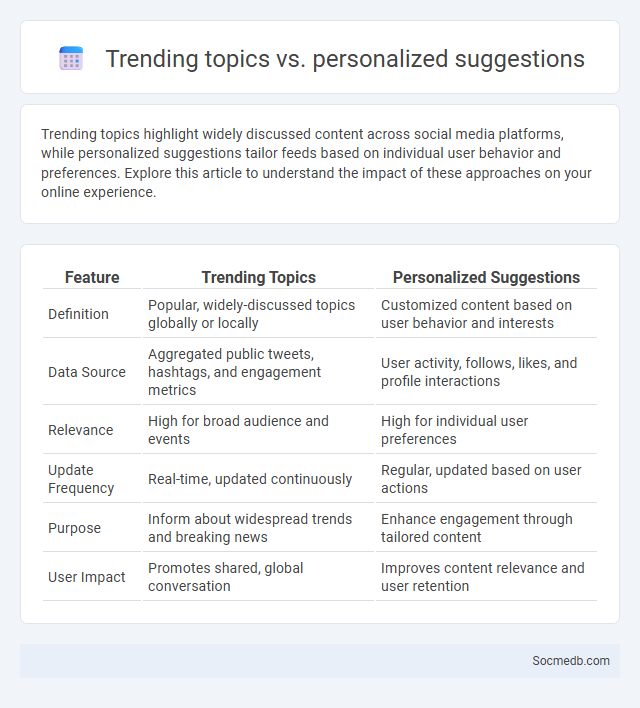
Photo illustration: Trending topics vs Personalized suggestions
Trending topics highlight widely discussed content across social media platforms, while personalized suggestions tailor feeds based on individual user behavior and preferences. Explore this article to understand the impact of these approaches on your online experience.
Table of Comparison
| Feature | Trending Topics | Personalized Suggestions |
|---|---|---|
| Definition | Popular, widely-discussed topics globally or locally | Customized content based on user behavior and interests |
| Data Source | Aggregated public tweets, hashtags, and engagement metrics | User activity, follows, likes, and profile interactions |
| Relevance | High for broad audience and events | High for individual user preferences |
| Update Frequency | Real-time, updated continuously | Regular, updated based on user actions |
| Purpose | Inform about widespread trends and breaking news | Enhance engagement through tailored content |
| User Impact | Promotes shared, global conversation | Improves content relevance and user retention |
Introduction to Content Discovery Methods
Content discovery methods on social media utilize algorithms, user behavior analysis, and personalized recommendations to enhance user engagement and deliver relevant information. Machine learning models process patterns such as likes, shares, comments, and browsing history to curate tailored content feeds. Platforms like Facebook, Instagram, and TikTok continuously refine these methods to optimize content relevance and maximize user retention.
Defining Trending Topics in Digital Platforms
Trending topics on digital platforms represent the most discussed or popular subjects within a set timeframe, driven by user engagement such as shares, comments, and likes. These topics are identified through algorithms analyzing hashtags, keywords, and user interactions, reflecting real-time public interest and cultural shifts. Your ability to leverage trending topics effectively enhances content visibility and audience engagement across various social media channels.
The Rise of Personalized Suggestions
The rise of personalized suggestions on social media platforms leverages advanced algorithms and user data to tailor content, ads, and recommendations uniquely to Your preferences. These personalized experiences increase engagement by presenting relevant posts, products, and connections based on Your interactions and behavior. As a result, social media evolution emphasizes user-centric models that enhance satisfaction and time spent on platforms through targeted, dynamic content delivery.
How Algorithmic Timelines Work
Algorithmic timelines on social media platforms prioritize content based on user engagement, relevance, and recency to enhance personalized experiences. These algorithms analyze user interactions such as likes, comments, shares, and viewing time to determine which posts appear higher in the feed. Machine learning models continuously adapt to user behavior patterns, ensuring the most relevant and engaging content is showcased.
Comparing User Engagement Across Approaches
User engagement varies significantly across social media platforms, with video content often generating higher interaction rates than text-based posts. Analytics show that Instagram Stories and TikTok reels drive up to 70% more user interaction compared to traditional image posts on Facebook or Twitter. Understanding these differences can help you tailor your social media strategy to maximize engagement and reach your target audience effectively.
The Pros and Cons of Trending Topics
Trending topics on social media offer timely insights into current events and popular culture, boosting your engagement and visibility by connecting you with a wide audience. However, these topics often change rapidly, leading to short-lived content relevance and potential exposure to misinformation or polarizing opinions. Balancing participation in trending discussions with thoughtful content creation helps maintain your credibility and audience trust.
Personalization: Benefits and Potential Pitfalls
Personalization on social media enhances your user experience by delivering tailored content and advertisements that align with your interests, increasing engagement and relevance. However, excessive personalization can create echo chambers, limiting exposure to diverse perspectives and potentially leading to biased information consumption. Balancing personalized content with varied viewpoints ensures you benefit from social media without falling into narrow content filters.
Algorithmic Timelines and Information Bubbles
Algorithmic timelines on social media platforms tailor your feed based on engagement patterns and preferences, often prioritizing content that aligns with your past interactions. This personalization can create information bubbles, limiting exposure to diverse viewpoints and reinforcing existing beliefs. Understanding how algorithms curate content helps you recognize biases and seek balanced information beyond curated timelines.
Impact on Content Diversity and Quality
Social media platforms significantly influence content diversity by enabling a wide range of voices and perspectives to reach global audiences, fostering inclusive and varied digital environments. However, algorithm-driven feeds can prioritize sensational or homogeneous content, potentially diminishing overall quality and reducing exposure to diverse viewpoints. Your engagement patterns directly affect the balance of content you encounter, shaping both the richness and reliability of information in your social media experience.
Future Trends in Content Recommendation Systems
Future trends in social media content recommendation systems emphasize enhanced personalization through advanced machine learning algorithms and AI-driven behavior analysis. Emerging technologies like natural language processing and computer vision enable platforms to deliver context-aware, real-time suggestions tailored to individual user preferences and engagement patterns. Privacy-preserving techniques, including federated learning and differential privacy, are becoming integral to maintaining user trust while optimizing recommendation accuracy.
 socmedb.com
socmedb.com